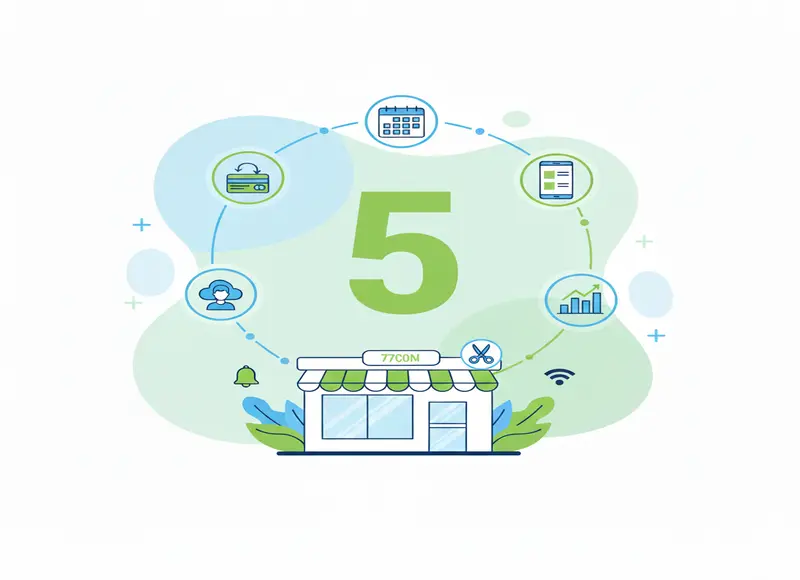Table of Contents
Modern buyers’ needs are different from what they were even 10 years ago. This means that modern sellers also have to change their business approach to stay afloat. But when everything is digital how to make real money on eCommerce?
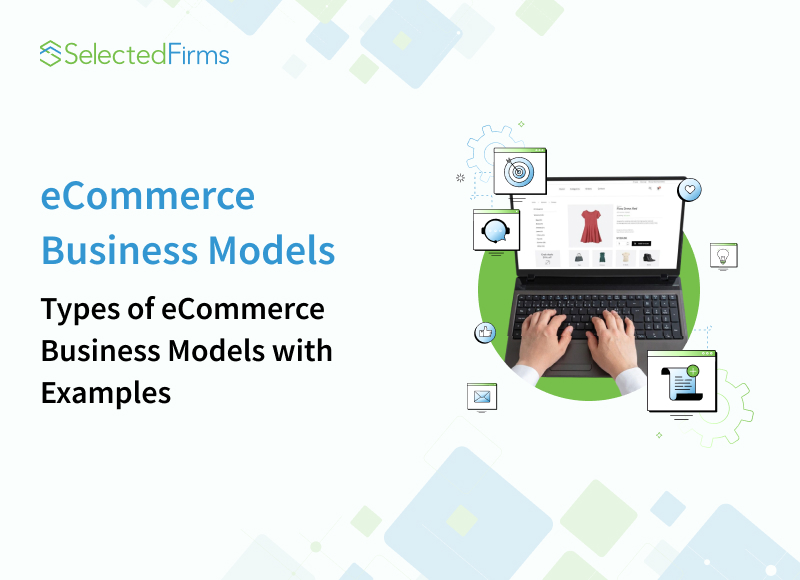
Modern buyers’ needs are different from what they were even 10 years ago. This means that modern sellers also have to change their business approach to stay afloat. But when everything is digital how to make real money on eCommerce? Fortunately, there are many working options to organize your business and stay profitable.
We admit that the classification of eCommerce business models can be overwhelming. But don’t worry, we unscrambled everything for you and described all the options in detail. To give you even more useful info from this article we will provide eCommerce business model examples to show how all these strategies are applied practically.
First of all, business models can be explored with different approaches. Here is how it looks.
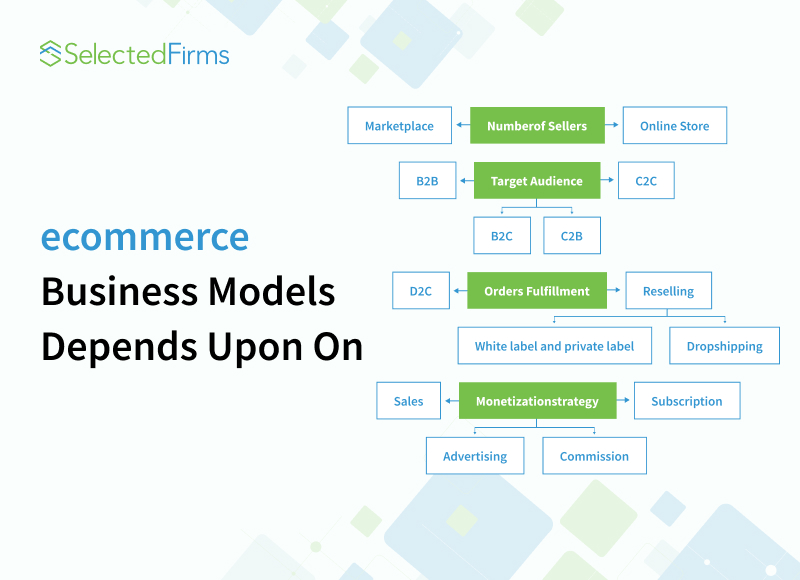
Now we will cover every approach comprehensively. So let’s start!
Marketplace vs Online store
When you build an eCommerce business there are two possible directions: sell products yourself (online store) or let others sell there (marketplace).
Online marketplace
Online marketplace is a platform where multiple third-party sellers are united under one shopping system. As an owner of such a platform, you will mediate between buyers and sellers. It is on you to maintain adequate demand and supply, security, and comfortable conditions for all the parties. In return, you can charge a fee from participants for your service by applying commission, subscription, or paid promotion.
The profit from the marketplace can be higher but building it might be challenging. You will need a development team to create such a multi-functional website. If you don’t have an on-site team then find outsourced professionals who will create a customized system matching your requirements.
Example: AliExpress, a global virtual marketplace, which focuses primarily on selling cheap products (produced mostly in China). AliExpress doesn’t have its own brands and shows items from third-party manufacturers. This platform allows entrepreneurs from all over the world to present their stores and sell goods there. Customers can buy items individually and in bulk.
Online store
An online store has only one seller – you. So there is no need to find other vendors, just attract customers to the store. In this model, business owners have control over everything, including money – profit is achieved directly through sales, not commission.
There are fewer problems with security and trust, as you are responsible for the quality and aware of what and how you sell. An online store doesn’t need such complex functionality as a marketplace does. Moreover, today there is no problem in building an online store as many platforms like Shopify or WooCommerce offer canned solutions for this. And there are also many ways to increase traffic to your store so you won’t struggle to find customers.
Example: Skullcandy is a brand of audio-electronic products. This online shop offers high-quality headphones and earphones. The website has an outstanding design and great content, which distinguishes the company from many competitors. As a result, customers enjoy shopping there not only due to brand recognition. WhatsApp marketing, with its multiple features, is another platform to start and grow your eCommerce business within a few clicks.
Business vs Consumer: B2B vs B2C vs C2C
A business model also depends on the target audience, namely who sells for whom. There are 4 traditional types: B2B, B2C, C2C, C2B. Let’s explore each of them individually.
B2B eCommerce Model
Businesses sell to other businesses. In this case, buyers can either be the end-user or resell items to consumers. Transactions in this model have a longer cycle, the order price is higher, and purchases are recurring. Therefore, customers tend to do more research before choosing where to buy. Digitalization in the B2B model helped to reduce expenses and simplify order procedures. But it is still important to build user-friendly websites to attract a loyal clientele.
Example: Berlin Packaging. This company produces and supplies packing materials, like containers and closures, for big and small businesses. They existed for many years offline and then successfully joined the eCommerce world. The company stays competitive as they offer a great customer experience on their website.
B2C eCommerce Model
Businesses sell to customers (end-users). The B2C eCommerce business model implies a much shorter decision-making process as items usually have lower costs than in B2B. It leads to a higher number of transactions, although with a lower value. Buyers’ behavior in this model is significantly different from the previous one. Competition here also might be higher. So you must choose a proper CMS to cover all your requirements and create a great user experience so customers will return to the store.
Example: Amazon is a world eCommerce giant. They started back in 1994 as a book retailer but soon diversified to sell DVDs and electronics. Today they offer their customers everything from food to high-tech, along with video streaming services, etc. Their secret of success is variety, reasonable prices, good customer service, and constant innovations.
C2B eCommerce Model
consumers sell to businesses. In this model, individuals are allowed to sell their products or services to companies. Such platforms can also connect freelancers with businesses who want to buy their service or content. This strategy is very widespread nowadays as it lets companies hire outsourced specialists to perform project work.
Example: Shutterstock. Freelance photographers sell their pictures and videos to businesses and earn money when someone buys their content. After an image or video is submitted by the author to the platform, buyers purchase it and receive rights to use it. Some of the content does not imply exclusive ownership and is sold multiple times to different buyers.
C2C/P2P eCommerce Model
consumers exchange services or goods with other consumers with the help of a third-party platform. The website simply assists in facilitating the deals between individuals. eBay, Airbnb, and Craigslist along with other p2p platforms work this way. The main problem is quality control which leads to a lot of fraud within the platform. The C2C model is an important part of the sharing economy which has become more and more popular lately. These platforms help find rare items or sell ones that are difficult to locate elsewhere.
Example: Craigslist, a platform for online ads. This website allows users to create listings and find someone who will respond. Basically, it is a digital version of a classified section in newspapers. The ads’ content might be from job offers to sell accessories.
Order fulfillment types: D2C, White-label, Dropshipping
If you sell physical items eCommerce business models also differ according to methods of supplying the goods. There are the following ways to fulfill your orders: sell and deliver what you manufacture or sell what is produced by an outsourcing company.
D2C eCommerce Model
D2C stands for direct to consumer which means there is no extra party mediating the transaction between seller and buyer. In this case, a manufacturer produces and distributes his product to end-users directly avoiding all middlemen.
Research shows that most consumers prefer buying directly from the manufacturer which makes this model very appealing among other forms of eCommerce business. The problem is that more often than not producers prefer selling their products in bulk. And this distances them from end-users who want to buy individual items. But those who move away from wholesale-only manage to build a strong relationship with customers.
Example: Larq, a crowdfunded project that managed to raise $1.7 million for their clean water initiative. The company produces reusable self-cleaning water bottles. Buyers are so fascinated by this eco-friendly product that the company’s revenue keeps on growing year by year.
Reselling
Reselling is buying goods from suppliers and reselling them to consumers. In this model, business owners do not manufacture products. Reselling can exist in different forms, such as white/private label or dropshipping.
White label
White label is applying your brand name to the goods bought from another retailer. This strategy works well if market demand for your product is already high. However, many suppliers have an obligatory minimum order quantity so you must be sure that your product will be sold. Otherwise, you will need to keep all the items to yourself.
Example: Fenty Beauty, Rihanna’s cosmetic brand. The company has a deal with Kendo holdings which produce white-label beauty products. This company also manufactures goods for Marc Jacobs and Kat Von D. Kendo knows how to make cosmetics, while famous brands know how to sell it, so it is win-win cooperation for every side.
The private label
The private label implies hiring a manufacturer to make a unique item and sell it exclusively under your brand. This is a great strategy when you have an idea but don’t want to deal with manufacturing. Manufacturers can either send finished products to the customers directly or the selling company. This model allows you to change a supplier if any problems arise or quickly adapt your product to the customer’s request.
Example: AmazonBasics is a brand for household goods. Amazon finds best-selling non-branded products manufactured by someone else, labels and lists them as high-quality Amazon products with a low price. This helps Amazon compete with third-party sellers within their marketplace.
Dropshipping
It implies the existence of a middleman who connects buyers and manufacturers. You don’t need to store any inventory as items are shipped to customers directly from the suppliers. You just need to have a nice website so the customers could find the goods and order them from you.
Example: Inspire Uplift. They offer a variety of products (from kitchenware to pet accessories) for affordable prices. Inspire Uplift doesn’t produce the items, just distributes what is in demand. They proved that dropshipping model works by staying on market for a long time.
AliExpress is another great example of dropshipping. Sellers buy no-name goods from manufacturers and ship them to customers all over the world via AliExpress.
Revenue models: Sales, Advertising, Commission, Subscription
Finally, eCommerce business models can be divided by the ways to earn money. There are such monetization options:
Sales
Profit is achieved by selling products or services on the platform. This is the primary income strategy for every online store. Sales via the internet help to reach out to a wider audience, while customers enjoy having access to virtually any product in the world and saving time.
Example: Etsy, an online marketplace for artists selling handmade items. This platform facilitates the deals between craftsmen who want to earn money and customers who want to get unique products. And this strategy is the key to success.
Advertising
Sellers or vendors pay for the promotion of their products on your website. This monetization strategy is mostly used on marketplaces where sellers are looking for ways to stand out. You can allow premium placements in search and banner ads for a fee.
Example: eBay, an online auction. The platform offers promoted listings for sellers to expose their products to more customers. They charge a fee from the seller after buyers click on a promoted ad and buy an item.
Commission
Sellers pay a fee for each transaction that happens on the platform. This model is very popular in eCommerce, especially for marketplaces. If you are the owner of a marketplace commission is your service fee for providing the platform for the buyers and sellers to meet.Sellers can use Sample Invoices Receipt Templates to track transactions easily. This helps them manage payments and finances smoothly.
A commission is usually a percentage of the order value. The numbers vary depending on the niche, here are some examples:
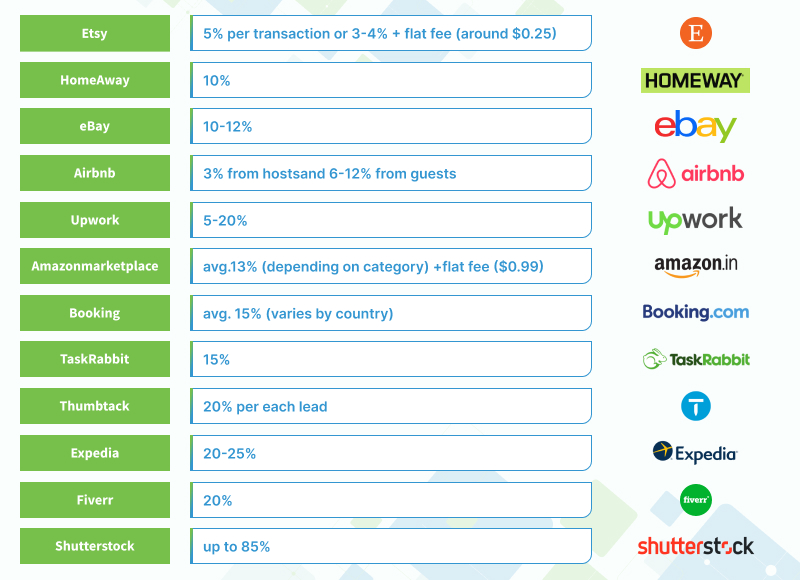
Commission rates on different eCommerce platforms
Example: Airbnb, a platform for property renting. The company charges commission from both sides: hosts who own the property pay on average 10% flat for every booking, while guests who travel pay 3% per transaction. People prefer this service to stay in hotels so the model shows its viability.
Subscription
Users pay regularly (usually monthly or annually) for the deliveries of goods or services. For instance, it is the most popular monetization strategy for software vendors, it is called Software as a Service (SaaS). It is so popular because with this model your income is pretty stable.
Example: Spotify, a music streaming service. The platform offers its users paid pricing plans after a short period of free use. The premium plan gives its users additional benefits, like the higher sound quality and the ability to download tracks and manage playlists.
Mixed revenue models
Two heads are better than one – same works for business models. That is why most enterprises combine several of the mentioned basic revenue models. This strategy helps to boost the income by utilizing a few channels and making it more reliable at the same time in case one of the sources fails.
Example: Wish uses both commission and advertisement. The platform markets a myriad of cheap goods but still manages to stay profitable. How? They oblige merchants to pay 15% from every purchase. Additionally, they offer paid promotion campaigns with unlimited budgets to let merchants’ items appear higher in listings.
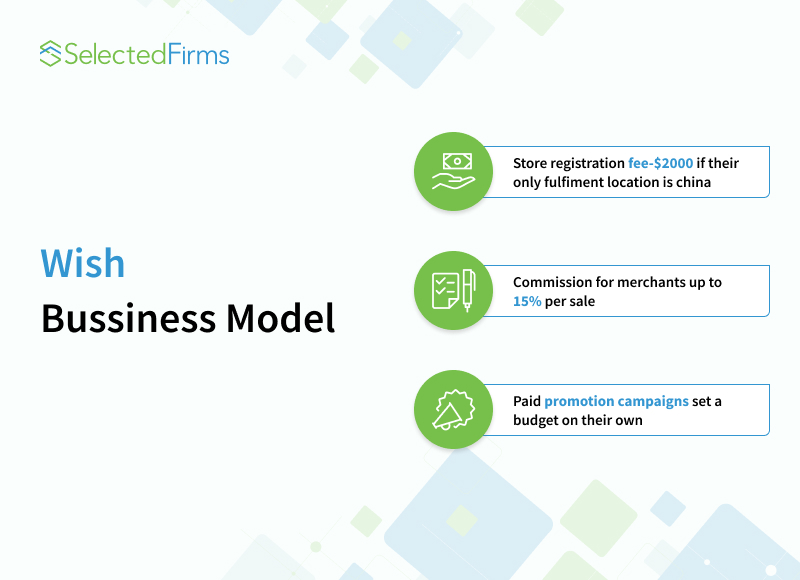
Amazon eCommerce business model is also combined. Their revenue consists of profit from sales of their own goods and commission and listing fees for third-party merchants. The platform takes a commission from its sellers for product promotion, too. Amazon Prime also charges monthly fees from subscribers for giving them access to video and music streaming. And there is no hesitation that their business model works excellent.
Etsy utilizes more than one monetization source as well. There are listing fees for sellers ($0.20 for every item) which last 4 months and then can be extended if necessary. Etsy charges a 5% commission from sellers for every transaction (or flat fee if paid through Etsy Payments). Additionally, the platform offers a paid subscription (Plus and Premium Package) and promotion (12-15% of item price) for users.
Wrapping up
To sum up, while choosing which model to apply to your business answer such questions:
1.Will you sell or let others sell on your website? (Online store vs marketplace)
An online store is a platform for a single merchant, a marketplace is a system that unites multiple vendors. The last one requires more complex functionality and severe quality control.
2. Who will buy from whom? (B2B, B2C, C2B, C2C)
The bargains on your website can happen between businesses only (B2B), customers only (C2C), or businesses and customers can interact with each other (B2C, C2B).
3. How will orders be fulfilled? (D2C, reselling)
Sellers can manufacture and sell their own products or cooperate with outsourced manufacturers who will produce items for their brands.
4. How will you earn money? (Sales, advertising, commission, subscription)
Your revenue can be achieved through selling products or services, promotion of products within the platform, extra fees from transactions, or subscription to regular service or product provision. Most businesses combine a few strategies to increase their income.
Now, you are familiar with all the possible ways to set up your type of eCommerce business. Remember, that these approaches can be incorporated, e.g. you can build a B2C online store with white label products and make money from sales. And if it is done well and your offer matches demand on market, then you win.
As we finished with the theoretical part it is time to build your website. Great, if you have a development team, but in case you don’t – outsourcing can help in many areas. No matter what you choose – good luck on your journey to success!
Author Bio: Inna Lebedeva is a market researcher and writer at eCommerce web development company. She explores today’s trends in the IT business and provides useful insights for startups. Inna covers a wide array of topics from remote work to eCommerce development. Her writing is always based on deep research and expert interviews.
Recent Blogs
9 Operational Excellence Strategies: How Leading Enterprises Optimize Performance
-
24 Dec 2025
-
6 Min
-
71





